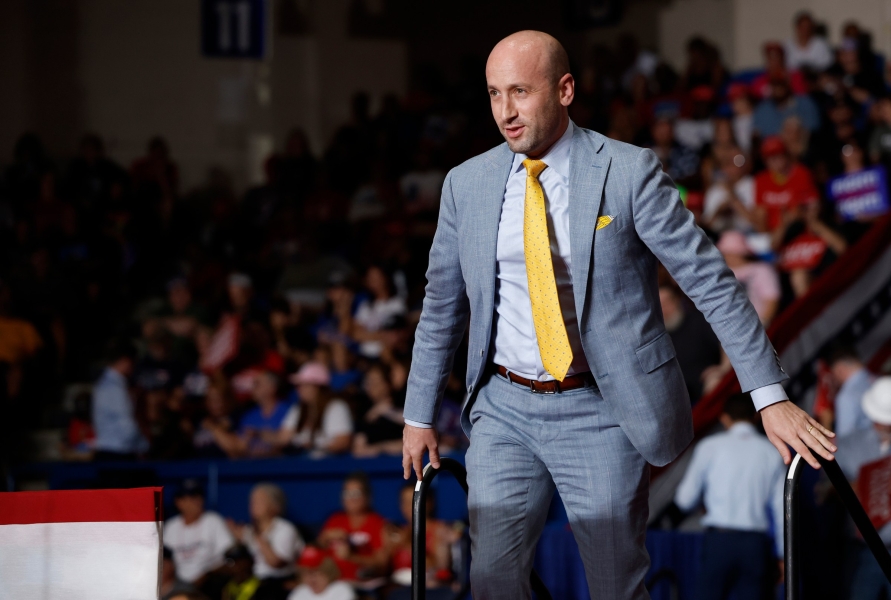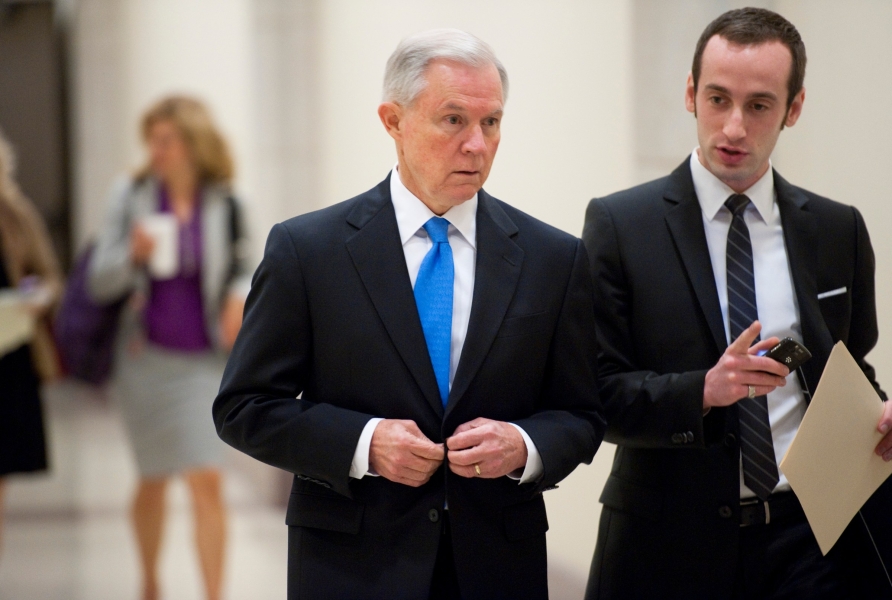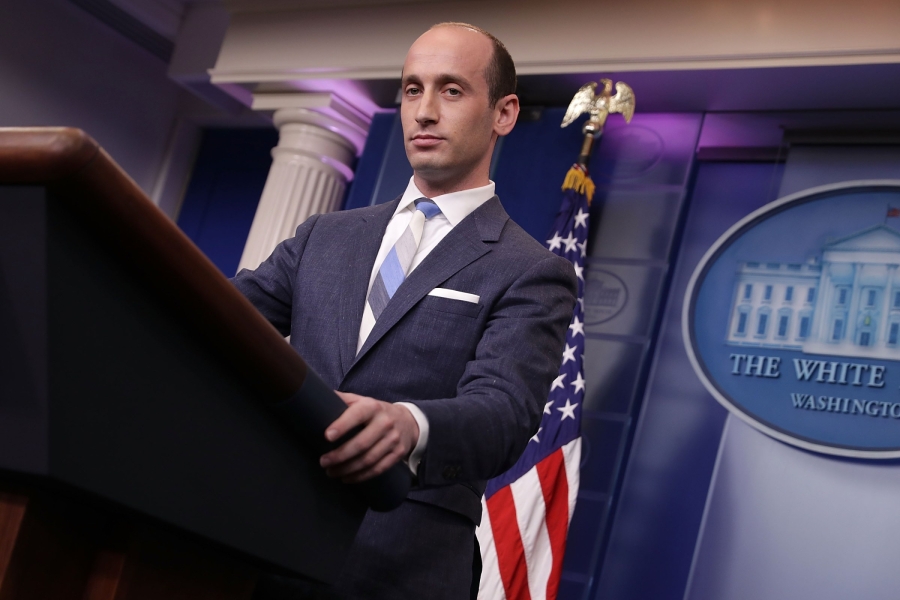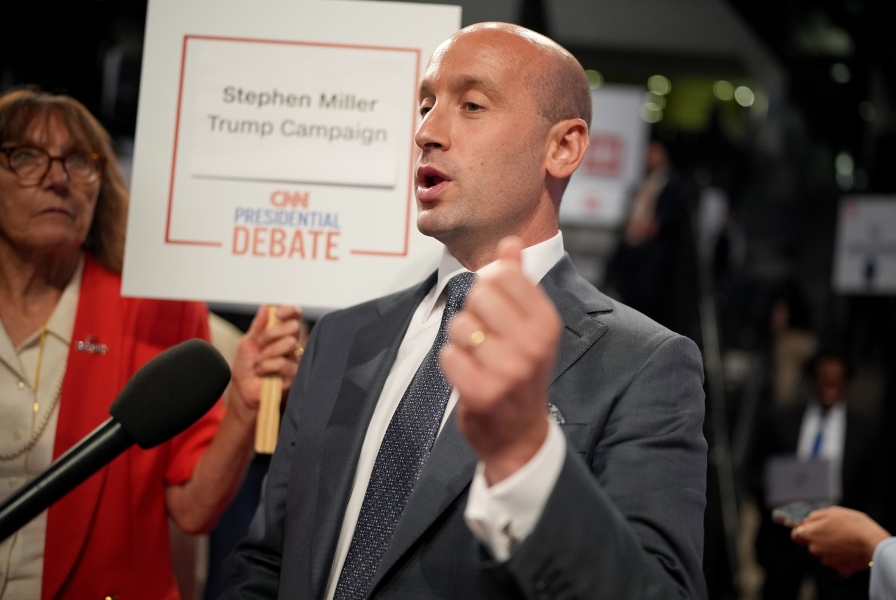
There is one person who knows, better than any other, what’s coming if Donald Trump wins a new term in office. And it isn’t Trump.
It’s Stephen Miller, the powerful adviser who has spent the past decade trying, with obsessive zeal, to rid the United States of unauthorized immigrants — and cut down on legal immigrants, too.
Miller was the architect of Trump’s immigration policy agenda for his entire first term. And, it is overwhelmingly believed, he will hold that role again in a potential Trump second term. His constant obsession, which he harps on in public and in private, is smearing unauthorized immigrants as dangerous and evil criminals who are killing and raping Americans.
Earlier this month, after the Trump-Harris debate, Miller ended up yelling at a reporter, and explained: “I’m yelling because children are being raped and murdered by illegal immigrants!” Trump and his allies’ recent demonization of Haitian immigrants comes straight from the Miller playbook; he has enthusiastically spread false reports of Haitians “eating neighborhood pets.”
Related:
- Republicans’ racist, cat-eating conspiracy theory, briefly explained
But Miller pairs that zealous fury with an ability to plunge into the depths of the federal bureaucracy, pushing personnel and policy levers to try and actually make his agenda happen. “He is by far the most successful bureaucrat that I’ve ever experienced,” a former DHS official who had worked in the federal government for three decades told journalist Jean Guerrero for her book about Miller, Hatemonger.
Now, Miller has had four years to stew over what he wasn’t able to accomplish in Trump’s first term, and make a detailed plan for how he’d do things differently next time. Articles about Trump’s second-term plans for “sweeping raids, giant camps, and mass deportations” have been mainly based on Miller’s statements. “For those passionate about securing our immigration system… the first 100 days of the Trump administration will be pure bliss — followed by another four years of the most hard-hitting action conceivable,” Miller told Axios last year.
Though Trump is running on the promise of “mass deportation now,” some commentators have been skeptical he will be able to achieve such a thing. It’s true that practical obstacles will inevitably appear, and that he surely won’t be able to deport all 11 million unauthorized immigrants. But it would be a mistake to underestimate Miller’s fanatical commitment to getting as far toward that goal as he can. He is on a mission — this has been the driving cause of his adult life. With a more MAGA-fied executive branch, a further right Supreme Court, and a public backlash against immigration, he could be far more successful at achieving it this time.
How Stephen Miller went from an obscure Hill press staffer to one of the country’s most powerful policymakers

Miller began his career as a right-wing provocateur early, writing op-eds and making talk radio appearances denouncing “political correctness” at his “left-wing high school” — a diverse Southern California school with many Latino students, who, Miller claimed, were too often failing to learn “basic English skills.” Once in college at Duke University, he helped organize a campus event featuring the controversial author Peter Brimelow, who was known for arguing that a wave of nonwhite immigrants from the “third world” was perniciously transforming the “ethnic character” of the US. Radical Islam was another fixation, as he organized an “Islamofascism Awareness Week.”
Miller also gained national press attention for defending three white lacrosse players from Duke who had been charged with raping a Black woman they’d hired as a stripper, in a case that caused a firestorm of national controversy. Miller argued that the “racial left” was rushing to judgment with mob-like hysteria — and indeed, the case eventually collapsed amid questions about the accuser’s credibility and serious prosecutorial misconduct.
After graduation, Miller landed a series of Capitol Hill jobs — including with Rep. Michele Bachmann (R-MN) — but his key gig turned out to be for Sen. Jeff Sessions (R-AL). In 2013, it would have sounded absurd to suggest that Sessions’s 27-year-old communications director would very soon become one of the most powerful policy aides in the country. Sessions was a fringe figure, a colorful crank known for ranting ineffectually about the horrors of immigration and free trade, and Miller was merely the guy who sent his overheated press emails. Republican leaders paid the pair little mind.
But as GOP establishment figures recommended the party embrace a bipartisan Senate immigration deal, a nativist backlash was brewing. Miller helped stoke it, circulating policy briefings claiming the bill was a sellout to the forces of amnesty and making alliances with establishment-critical media figures like Tucker Carlson and especially Steve Bannon, the head of Breitbart News. (The immigration bill passed the Senate but died in the GOP-controlled House due to right-wing opposition).
A former Breitbart reporter, Katie McHugh, has claimed that Miller essentially had “editorial control” over much of the site’s coverage during these years, crafting its coverage of lurid crimes committed by unauthorized immigrants. Emails leaked by McHugh show that Miller sent along articles from racist and white nationalist websites, and that he seemed obsessed with the race and ethnicity of criminals (at one point, he asked for coverage about an Oregon school shooter being “mixed race”).
In the early 2010s, even conservative Republicans tended to say that they only opposed illegal immigration, but that the legal kind was just fine. Miller believed differently. Like Brimelow, Bannon, and Sessions, Miller believed that a bipartisan elite class of “cosmopolitan” globalists had been selling out the American people for years by letting in the wrong kind of people legally. In emails to McHugh, he fulminated against the 1965 law that opened the US’s doors to millions more Latin American, Asian, and African immigrants. “Elites can’t allow the people to see that their condition is not the product of events beyond their control, but the product of policy they foisted onto them,” Miller wrote.
Related:
- The 6 thinkers who would define a second Trump term
So when Donald Trump ran for president on a platform of denouncing Mexican immigrants as criminals and rapists, banning Muslims from entering the US, and condemning establishment GOP leaders as sellouts, Miller saw his opportunity, joining Trump’s campaign in January 2016. Sessions then became the first senator to endorse Trump the following month, while Bannon made Breitbart the most Trump-friendly media outlet, and eventually joined the campaign officially in August.
When Trump won the presidency, the trio got top administration jobs: Sessions as attorney general, Bannon as White House chief strategist, and the now 31-year-old Miller as a senior White House policy adviser. The fringe had become the new GOP establishment, and they could now put their ideas into action.
“The president of immigration”: Stephen Miller in power

Both Bannon and Sessions crashed and burned, eventually being fired by Trump. But Miller lasted — and remained laser-focused on implementing Trump’s anti-immigrant agenda. He made clear at every turn that he was unshakably loyal to Trump himself. And he proved to be an effective bureaucratic turf warrior.
The controversial and chaotic travel ban Trump issued in his first week in power — blocking people from seven majority-Muslim countries, even green card holders, from entering the US — had Miller’s fingerprints all over it. This sloppy first attempt was blocked by courts, but a retooled, less blatantly discriminatory version eventually got the Supreme Court’s approval.
Settling in, Miller’s constant presence at the head of policy meetings made it clear he was “the president of immigration,” as one official told Politico. (He often opened such meetings by reciting horror stories of immigrant crimes, and urged fellow officials to circulate stories of such crimes). Other top Trump appointees generally ceded the issue to him, believing he and Trump had a mind meld on it. Miller also oversaw the White House speechwriting office, helping shape Trump’s prepared remarks.
He would frequently call lower-level agency officials with aggressive demands, berating them if he viewed them as ineffective or recalcitrant. “You ought to be working on this regulation all day every day,” he told officials at one meeting, per the New York Times. “It should be the first thought you have when you wake up. And it should be the last thought you have before you go to bed. And sometimes you shouldn’t go to bed.”
In spring 2019, frustrated by the lack of progress, he engineered a purge of nearly all of DHS’s top immigration policy officials. After DHS’s top lawyer had too many pesky complaints about whether what he was being asked to do was legal, he too was fired. “Every single year,” Miller later said on a podcast, “we became more efficient, more knowledgeable, and more skilled about how to use the bureaucracy.” He learned, he went on, “how to identify like-minded federal officials, and how to remove and program around those who weren’t on the team, how to install lawyers and political appointees to the right level to get things done.”
Miller’s hostility was not limited to unauthorized immigrants. He wanted fewer lawfully admitted Middle Eastern and Afghan refugees, reportedly asking at one meeting, “What do you guys want? A bunch of Iraqs and ’stans across the country?” He pushed forward a rule denying green cards to legal immigrants who received public benefits or who might receive such benefits in the future. One “Kafkaesque” policy automatically denied green card applications if a single field was left blank.
And once the pandemic broke out, Miller seized on it to close off pathways for new legal immigration as well, blocking new family-based immigration and work visas, with Miller saying he wanted to “turn off the faucet of new immigrant labor.”
Still, Miller’s main priority in the first term was to stop new migrants from arriving at the southern border. He shaped a series of policies toward that end — family separation, which caused a nationwide uproar by detaining migrant children separately from their parents; Remain in Mexico, which said many asylum seekers had to stay outside the US while their claims were processed; and Title 42, which expelled arriving migrants for public health reasons once the pandemic began.
“By 2020, we completely shut down access to the US asylum system,” Miller later bragged to conservative commentator Charlie Kirk. “Everybody was being expelled without any ability to apply for asylum in the United States.”
Yet people kept coming. Though new border apprehensions, the statistic thought to best track how many unauthorized migrants are arriving, had fallen from its 2019 peak, it remained around the level of Obama’s second term.
And “mass deportation” simply hadn’t happened. Hemmed in by limited resources (ICE only has about 6,000 deportation officers nationwide), slow court proceedings, adverse judicial rulings, and the unwillingness of blue states and cities to cooperate, Trump ended up deporting fewer people than Obama in either of his terms. A DHS official later told the Washington Post that they “didn’t really get significant pressure” in deportations; though Trump would intermittently complain about the issue, he cared more about building his wall.
“It will be joyous”: Miller’s mass deportation dreams for a second Trump term

When Trump left office on January 20, 2021, the backlash to his attempt to stay in power made it far from clear he’d ever get near the presidency again. So Miller used these years to branch out somewhat. In line with the new cause of the moment among conservative activists, he launched a crusade against “wokeness” and diversity, equity, and inclusion (DEI) programs, and started a nonprofit to file lawsuits to try and bring them down. As is typical for Miller, the racial element was emphasized; before the 2022 midterms his group ran an ad in Georgia asking: “When did racism against white people become OK?”
But the Biden years soon made clear the immigration issue was becoming more prominent than ever. Due to some combination of the ebbing of the pandemic, upheaval abroad, and Biden’s own more lenient immigration stances, new border apprehensions soared to their highest level in decades. While Trump was president, Democrats had positioned themselves as defenders of unauthorized immigrants against the president’s hostility. In 2022 and 2023, though, some Democrats in blue states and cities seeing an influx of migrants complained that too many people were coming.
Related:
- Biden’s border record: Trump’s claims vs. reality
The politics were ominous for Democrats. Polls showed a dramatic surge in the number of people who wanted less immigration. The Biden administration’s response was to try to let many more people in legally, in an orderly fashion, while trying to stop new people from coming and turning away more of the migrants who do arrive, including by restricting the asylum process in Miller-esque ways. Biden also sought a bipartisan immigration deal that would have entailed major concessions to conservatives — but Trump scuttled it.
By fall 2023, Trump was the overwhelming favorite to win the nomination again, and when reporters asked about his plans for a second-term immigration agenda, the campaign referred them to Miller: the mind meld remained.
As ever, Miller’s targets included immigrants here legally as well. Biden had used his own authority to let in more than 1 million people under the parole program; Miller calls that an “unconstitutional executive amnesty” and plans to revoke those people’s permission to be in the country. He wants to end the Obama-era DACA program, which lets unauthorized immigrants who had been brought to the US as children stay. He has also promised to revoke visas for people “whose views, attitudes, and beliefs make them ineligible to stay in the country” — like, he said, “the Hamas supporters who are rallying across the country.”
But Miller had also spent time brainstorming how to carry out the mass deportation that hadn’t happened in Trump’s first term. To solve the problem of ICE’s limited resources, he planned to ask red state governors to deputize their National Guard as immigration enforcement officers, as well as enlisting federal law enforcement officers from other agencies and local police. To address limited detention capacity (which in practice means many detained migrants get released), he would have massive camps built, probably in Texas. Faced with the prospect of prolonged detention in the camps, he hopes, many detainees would choose to waive their legal protections and accept deportation. All of this, he said, would rely on existing legal authority.
And the legal and practical obstacles that frustrated first-term Trump’s deportation campaign? Some have weakened significantly during Trump’s time out of office. Trump allies plan to get greater control over the civil service by issuing the “Schedule F” order, reclassifying thousands of career officials as political appointees who Trump could then fire and replace with loyalists. Miller has helped lead a push to identify MAGA lawyers who, if appointed to the administration, could be relied on to push aggressive policies without raising legal or moral complaints. And the lawsuits certain to be brought by immigration activists would now ultimately head to a more conservative Supreme Court.
Skeptics point out that most unauthorized immigrants live in blue states or cities, expecting they’ll prove uncooperative to Trump’s deportation push. Yet just how uncooperative they’ll be remains to be seen. Trump allies have brainstormed ways to coerce blue states, like withholding federal funding to local jurisdictions that don’t share residents’ immigration status information. And the #Resistance sentiment of Trump’s first term could be more muted this time around, particularly given the public’s anti-immigration turn.
“Understand,” Miller told Charlie Kirk last year, “this is going to happen.” If Trump won a second term, he said, “This is going to commence immediately.”
“And it will be joyous, and it will be wonderful, and it will be everything you want it to be.”
Source: vox.com